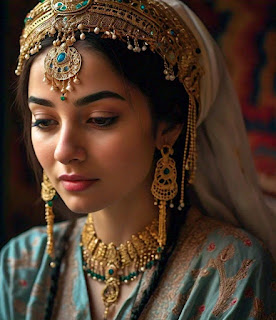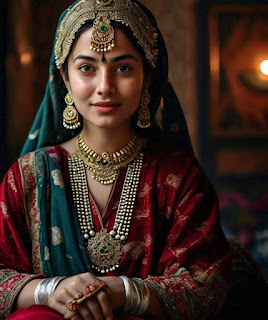Introduction Kashmiri Head Jewelry
Kashmiri head jewelry is an integral part of the rich cultural heritage of Kashmir, a region nestled in the Himalayas. For centuries, jewelry has played a significant role in Kashmiri tradition, symbolizing not only beauty but also social status, marital status, and spiritual beliefs. The intricate designs and craftsmanship of Kashmiri head jewelry are renowned worldwide, reflecting the region's unique blend of Mughal, Persian, and indigenous influences.
Kashmiri head jewelry is more than just an adornment; it's a reflection of the wearer's identity, cultural roots, and values. The various types of head jewelry, such as Jhumpa, Tikka, Mange Tikka, and Nath, are an integral part of a Kashmiri woman's attire, especially on special occasions like weddings and festivals. In this article, we will delve into the history, significance, and beauty of Kashmiri head jewelry, exploring its evolution, designs, and cultural importance.
Kashmiri head jewelry, known for its intricate craftsmanship and cultural significance, is a prominent aspect of traditional Kashmiri attire. This jewelry often features ornate designs incorporating precious metals like gold and silver, along with embellishments of pearls, semi-precious stones, and vibrant enamel work. Key pieces include the "Taranga," a headpiece worn by brides, which consists of a long, embroidered cap adorned with delicate chains and ornaments that gracefully cascade down the sides of the face. Another significant piece is the "dehook," a pair of gold pendants worn by married women, symbolizing marital status and familial bonds. Kashmiri head jewelry not only enhances the aesthetic appeal of traditional outfits but also embodies the region's rich heritage and the artisans' exquisite skills, passed down through generations.
History of Kashmiri Head Jewelry
The history of Kashmiri head jewelry dates back to the ancient period, with evidence of jewelry-making found in the Indus Valley Civilization (3300-1300 BCE). The region's strategic location made it a hub for trade and cultural exchange, influencing the development of jewelry craftsmanship. The Mughal Empire (1526-1756 CE), which ruled Kashmir, brought with them their own jewelry styles, further enriching the region's jewelry heritage.
During the Mughal era, Kashmiri jewelry-making flourished, with artisans creating intricate pieces for the royal court. The Mughals introduced new techniques, such as filigree work, and precious stones like diamonds, rubies, and emeralds became popular. The Persian influence also introduced floral and leaf motifs, which became characteristic of Kashmiri jewelry.
After the Mughal era, Kashmir came under Afghan and Sikh rule, during which the region's jewelry-making continued to evolve. The Dogra dynasty (1846-1947 CE), which ruled Kashmir, patronized jewelry-making, leading to a resurgence in traditional craftsmanship.
Types of Kashmiri Head Jewelry
Kashmiri head jewelry comprises various types, each with its unique significance and design:
- Jhumpa: Jhumpa is a type of earring that hangs below the earlobe, often adorned with precious stones and intricate filigree work. Jhumpa's are typically worn by married women and symbolize marital bliss.
- Tikka: Tikka is a forehead ornament worn by women, usually in the shape of a pendant or a small plaque. It's often decorated with gemstones and filigree work, signifying the wearer's social status.
- Mange Tikka: Mange Tikka is a headband worn by women, typically on special occasions. It's adorned with precious stones, filigree work, and floral motifs, symbolizing the wearer's cultural heritage.
- Nath: Nath is a nose ring worn by women, often decorated with gemstones and filigree work. It's a symbol of marital status and spiritual devotion.
Each type of head jewelry has its unique design, craftsmanship, and significance, reflecting the wearer's identity, social standing, and cultural roots.
Designs and Motifs
Kashmiri head jewelry is renowned for its intricate designs and motifs, which reflect the region's cultural heritage:
- Filigree work: Filigree work is a hallmark of Kashmiri jewelry, involving delicate threads of gold and silver woven into intricate patterns.
- Floral and leaf motifs: Floral and leaf motifs are inspired by the region's natural beauty, with designs often featuring lotus flowers, leaves, and vines.
- Precious stones and gemstones: Precious stones like diamonds, rubies, and emeralds are often used in Kashmiri head jewelry, adding to its beauty and significance.
- Intricate craftsmanship: Kashmiri head jewelry is characterized by intricate craftsmanship, with artisans spending hours perfecting each piece.
The designs and motifs used in Kashmiri head jewelry are not only aesthetically pleasing but also carry deep cultural and spiritual significance.
Significance and Symbolism
Kashmiri head jewelry holds significant cultural and spiritual importance, symbolizing:
- Marital status: Jhumpa's and Nath are symbols of marital status, with married women wearing them as a sign of marital bliss.
- Social standing: Tikka and Mange Tikka signify the wearer's social standing, with more intricate designs indicating higher social status.
- Spiritual beliefs: Kashmiri head jewelry is often adorned with spiritual symbols like the OM and the lotus flower, reflecting the wearer's spiritual beliefs.
- Cultural heritage: Kashmiri head jewelry is a reflection of the region's cultural heritage, with each piece telling a story of the region's history and traditions.
In conclusion
Kashmiri head jewelry stands as a testament to the region's rich cultural heritage and the unparalleled craftsmanship of its artisans. These exquisite pieces, adorned with intricate designs and precious materials, are more than mere adornments; they symbolize deep-rooted traditions and social customs. Whether through the elaborate taranga worn by brides or the symbolic dejhoor of married women, Kashmiri head jewelry continues to play a vital role in the cultural identity and aesthetic expression of Kashmir. Its enduring beauty and significance highlight the timeless nature of this traditional art form, making it a cherished aspect of Kashmiri heritage that is celebrated and preserved across generations.









.png)


0 Comments